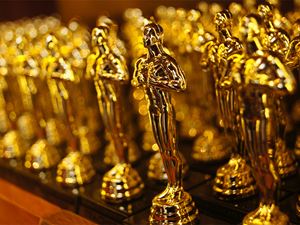
When the Academy of Motion Picture Arts and Sciences announced its nominations for the 95th Academy Awards in January, contenders included several movies with religion angles and numerous actors with faith backgrounds.
A short list for the ceremony, to be held March 12, 2023, includes the eco-spiritual themes of Avatar: The Way of Water, revivalist roots in the Elvis biopic starring Austin Butler and Tom Hanks, themes of “faith and fatness” in The Whale with Brendan Fraser, the Bible Belt cultural cues that are felt but never fully seen in To Leslie’s melancholic storyline, and confessions and questions of whether God cares about miniature donkeys in The Banshees of Inisherin.
That’s not even to mention Stranger at the Gate. Directed by Joshua Seftel, the film is about an Afghan refugee named Bibi Bahrami and the members of her Indiana mosque, who come face to face with a U.S. Marine who has secret plans to bomb their community center. That’s when the Marine's plan takes an unexpected turn. The moving real-life story is considered a favorite in the best documentary short film category.
Beyond awards season, 2023 has a slew of new religion-related releases sure to catch audience’s attention.
It’s safe to say that if you head to the movies – or catch the Academy Awards ceremony – this year, you’re likely to run into religion. But what might we learn about religion and culture from this year’s many intersections between faith and film?
Religion and film across the years.
To quote the Disney animated classic Beauty and the Beast, the relationship between religion and film is a tale “as old as time.” Or, at least, as old as filmmaking itself.
All the way back in 1911, when newsreels and motion pictures were still in their infancy, one of the earliest commentaries on cinema’s character and potential uses came from the Rev. Herbert A. Jump of Connecticut. In The Religious Possibilities of the Motion Picture, Jump “envisioned a fertile marriage” between the “moving pictures” and religion.
Since then, the relationship between religion and film has evolved. At times contentious, at other times copacetic, religion and the movies have been closely linked, with religious themes finding their way into films and religious movie makers, writers and performers all finding a way to express their spirituality on the silver screen.
It’s almost impossible to go the movies or engage with any kind of pop culture, without running into religious themes, characters, plots, or content creators. In fact, Edward McNulty, author of Jesus Christ, Movie Star, writes that other than Sherlock Holmes, James Bond, or Godzilla, Jesus is one of “the longest-running characters in world cinema.”
Movies as religion?
Beyond faith tie-ins and religiously motivated films, we can also consider the movie experience as a form of religion itself.
Religion scholar S. Brent Plate wrote that “religion and cinema share a capacity for world making, ritualizing, mythologizing, and creating sacred time and space” in his 2017 rerelease of Religion and Film: Cinema and the Re-creation of the World.
Others, like historian of U.S. religion David Morgan, view movies — religious or not — as modern forms of visual piety, like stained-glass windows in the European cathedrals of old, communicating religious themes and messages beyond text and rote tradition.
This idea is related to what anthropologist Harvey Whitehouse calls the shift from "doctrinal" to “imagistic" religions. Whereas the doctrinal mode of religion is characterized by a top-down hierarchy, involving regularly repeated daily or weekly rituals, written texts, standard teachings, and lower levels of emotional arousal, imagistic religion is less structured, with little or no hierarchy or doctrine, characterized by periodic festivals with high levels of emotion that mark a break from regular daily life.
Imagistic religions utilize ecstatic trance states and altered forms of consciousness to bring about direct divine contact; doctrinal religion employs mediators to interpret the divine. Imagistic can also be imagined in its literary sense in which it refers to poetry, dream logic, or the presentation of images to arouse reaction in consumers and audience members.
As religious adherents are looking to personalize, localize, pragmatize, and spiritualize their religious practice (over and against corporate, global, sentimental, and institutional forms of belief and practice) they increasingly look to media to do so.
Stewart Hoover, Director of University of Colorado’s Center for Media, Religion, and Culture, underscores this point when he writes:
“Media provide rich symbolism, visual culture, salient contexts and practices of social participation and identity, and opportunities to make and remake identities and social relationships to fit evolving patterns of ideas and action. The media are, further, the dominant and definitive source of what is socially and culturally important in modernity…. The entertainment and advertising media do so by creating and maintaining taste cultures through which identities are given value.”
Media then become our new “doubting Thomas” moments. Whereas Thomas was bidden to touch Jesus' side and feel his wounds, religion in the media age invites us to have a deeply religious experience via "cathode ray tubes" (to use Kurt Vonnegut’s anachronism for television) or be transported to another world on the big screen.
Either way, these media experiences are more than consumption -- we craft them into encounters with what we consider the divine.
Bad religion movies.
That means before you complain about subpar acting and shallow plotting in faith-based films or bemoan how religion is represented by the big production studios, take a moment to consider what these films are saying about the practice of religion in a more general sense.
Rather than evaluating a movie’s particular faith claims or whether their representations of religion are good, bad, or in between, think about how what Morgan calls the “object of representation.” In other words, what is being represented about religion here and what might it have to tell us about the filmmakers, or our own, understandings and appreciation of religion?
Whether it’s a psychedelic take on the divine in “Everything Everywhere All at Once” or Bollywood's representations of Hindu epics in films like “RRR," the many intersections of faith and film invite us once again to view religious aesthetics within the wider context of social reality."
That is to say, we have to understand how we ourselves are (re)creating religion -- and the world around us – in order to understand what is happening with the proliferation of religious movies and their popularity with audiences, or at the Academy Awards.
For further reading and exploration:
•Read Religion and Film: Cinema and the Re-creation of the World, by S. Brent Plate.
•Read Religion and Film: Representation, Experience, Meaning, by Stephanie Knauss.
•Read Muslims in the Movies: A Global Anthology, edited by Kristian Petersen.
•Read The New Jew in Film: Exploring Jewishness and Judaism in Contemporary Cinema, by Nathan Abrams.
•Read Silver Screen Buddha: Buddhism in Asian and Western Film, by Sharon A. Suh.
•Read Avatar and Nature Spirituality, by Bron Taylor.
•Read The Challenge of the Silver Screen: An Analysis of the Cinematic Portraits of Jesus, Rama, Buddha and Muhammad, by Freek L. Bakker.
•Read a selection of books on film and religion at JSTOR.
•Read articles from the Journal for Religion, Film and Media, from the University of Graz, Austria.
•Read a selection from the Routledge Studies in Religion and Film Series.
3/6/2023 4:20:18 PM





